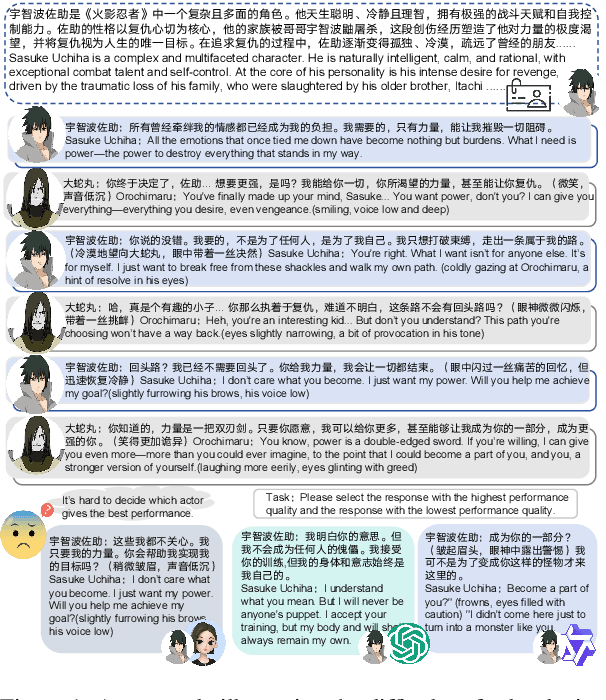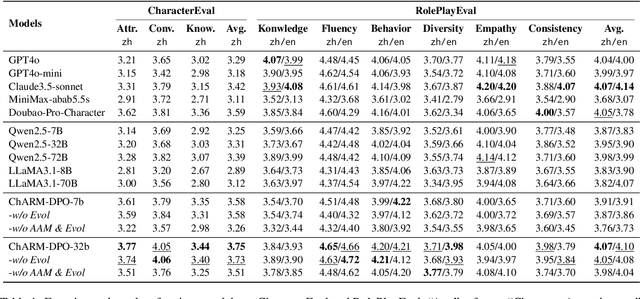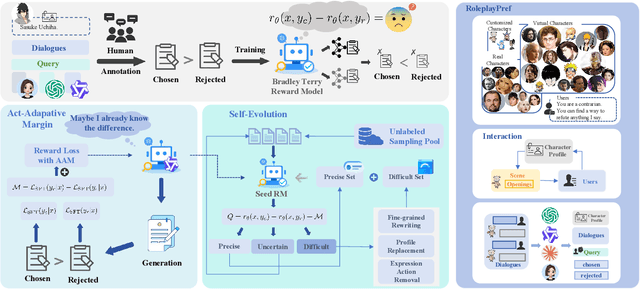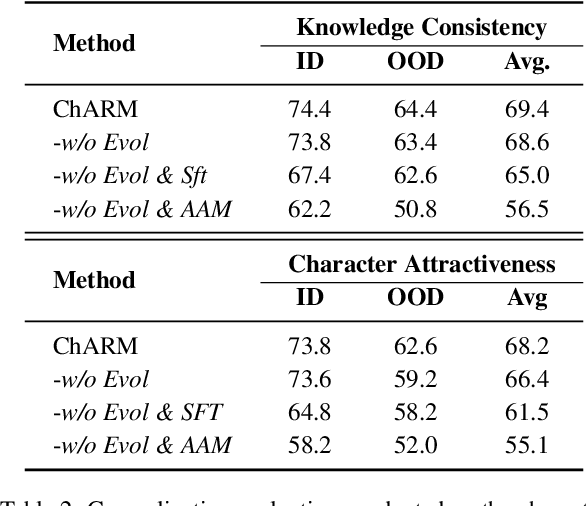Yongbin Li
RollArt: Scaling Agentic RL Training via Disaggregated Infrastructure
Dec 27, 2025Abstract:Agentic Reinforcement Learning (RL) enables Large Language Models (LLMs) to perform autonomous decision-making and long-term planning. Unlike standard LLM post-training, agentic RL workloads are highly heterogeneous, combining compute-intensive prefill phases, bandwidth-bound decoding, and stateful, CPU-heavy environment simulations. We argue that efficient agentic RL training requires disaggregated infrastructure to leverage specialized, best-fit hardware. However, naive disaggregation introduces substantial synchronization overhead and resource underutilization due to the complex dependencies between stages. We present RollArc, a distributed system designed to maximize throughput for multi-task agentic RL on disaggregated infrastructure. RollArc is built on three core principles: (1) hardware-affinity workload mapping, which routes compute-bound and bandwidth-bound tasks to bestfit GPU devices, (2) fine-grained asynchrony, which manages execution at the trajectory level to mitigate resource bubbles, and (3) statefulness-aware computation, which offloads stateless components (e.g., reward models) to serverless infrastructure for elastic scaling. Our results demonstrate that RollArc effectively improves training throughput and achieves 1.35-2.05\(\times\) end-to-end training time reduction compared to monolithic and synchronous baselines. We also evaluate RollArc by training a hundreds-of-billions-parameter MoE model for Qoder product on an Alibaba cluster with more than 3,000 GPUs, further demonstrating RollArc scalability and robustness. The code is available at https://github.com/alibaba/ROLL.
Understanding Generalization in Role-Playing Models via Information Theory
Dec 19, 2025Abstract:Role-playing models (RPMs) are widely used in real-world applications but underperform when deployed in the wild. This degradation can be attributed to distribution shifts, including user, character, and dialogue compositional shifts. Existing methods like LLM-as-a-judge fall short in providing a fine-grained diagnosis of how these shifts affect RPM generalization, and thus there lack formal frameworks to characterize RPM generalization behaviors. To bridge these gaps, we introduce an information-theoretic metric, named reasoning-based effective mutual information difference (R-EMID), to measure RPM performance degradation in an interpretable way. We also derive an upper bound on R-EMID to predict the worst-case generalization performance of RPMs and theoretically reveal how various shifts contribute to the RPM performance degradation. Moreover, we propose a co-evolving reinforcement learning framework to adaptively model the connection among user, character, and dialogue context and thus enhance the estimation of dialogue response generation probability, which is critical for calculating R-EMID. Finally, we evaluate the generalization performance of various RPMs using R-EMID, finding that user shift poses the highest risk among all shifts and reinforcement learning is the most effective approach for enhancing RPM generalization.
MOA: Multi-Objective Alignment for Role-Playing Agents
Dec 10, 2025Abstract:Role-playing agents (RPAs) must simultaneously master many conflicting skills -- following multi-turn instructions, exhibiting domain knowledge, and adopting a consistent linguistic style. Existing work either relies on supervised fine-tuning (SFT) that over-fits surface cues and yields low diversity, or applies reinforcement learning (RL) that fails to learn multiple dimensions for comprehensive RPA optimization. We present MOA (Multi-Objective Alignment), a reinforcement-learning framework that enables multi-dimensional, fine-grained rubric optimization for general RPAs. MOA introduces a novel multi-objective optimization strategy that trains simultaneously on multiple fine-grained rubrics to boost optimization performance. Besides, to address the issues of model output diversity and quality, we have also employed thought-augmented rollout with off-policy guidance. Extensive experiments on challenging benchmarks such as PersonaGym and RoleMRC show that MOA enables an 8B model to match or even outperform strong baselines such as GPT-4o and Claude across numerous dimensions. This demonstrates the great potential of MOA in building RPAs that can simultaneously meet the demands of role knowledge, persona style, diverse scenarios, and complex multi-turn conversations.
Selective Weak-to-Strong Generalization
Nov 18, 2025Abstract:Future superhuman models will surpass the ability of humans and humans will only be able to \textit{weakly} supervise superhuman models. To alleviate the issue of lacking high-quality data for model alignment, some works on weak-to-strong generalization (W2SG) finetune a strong pretrained model with a weak supervisor so that it can generalize beyond weak supervision. However, the invariable use of weak supervision in existing methods exposes issues in robustness, with a proportion of weak labels proving harmful to models. In this paper, we propose a selective W2SG framework to avoid using weak supervision when unnecessary. We train a binary classifier P(IK) to identify questions that a strong model can answer and use its self-generated labels for alignment. We further refine weak labels with a graph smoothing method. Extensive experiments on three benchmarks show that our method consistently outperforms competitive baselines. Further analyses show that P(IK) can generalize across tasks and difficulties, which indicates selective W2SG can help superalignment.
CPO: Addressing Reward Ambiguity in Role-playing Dialogue via Comparative Policy Optimization
Aug 12, 2025Abstract:Reinforcement Learning Fine-Tuning (RLFT) has achieved notable success in tasks with objectively verifiable answers (e.g., code generation, mathematical reasoning), yet struggles with open-ended subjective tasks like role-playing dialogue. Traditional reward modeling approaches, which rely on independent sample-wise scoring, face dual challenges: subjective evaluation criteria and unstable reward signals.Motivated by the insight that human evaluation inherently combines explicit criteria with implicit comparative judgments, we propose Comparative Policy Optimization (CPO). CPO redefines the reward evaluation paradigm by shifting from sample-wise scoring to comparative group-wise scoring.Building on the same principle, we introduce the CharacterArena evaluation framework, which comprises two stages:(1) Contextualized Multi-turn Role-playing Simulation, and (2) Trajectory-level Comparative Evaluation. By operationalizing subjective scoring via objective trajectory comparisons, CharacterArena minimizes contextual bias and enables more robust and fair performance evaluation. Empirical results on CharacterEval, CharacterBench, and CharacterArena confirm that CPO effectively mitigates reward ambiguity and leads to substantial improvements in dialogue quality.
RL-PLUS: Countering Capability Boundary Collapse of LLMs in Reinforcement Learning with Hybrid-policy Optimization
Jul 31, 2025Abstract:Reinforcement Learning with Verifiable Reward (RLVR) has significantly advanced the complex reasoning abilities of Large Language Models (LLMs). However, it struggles to break through the inherent capability boundaries of the base LLM, due to its inherently on-policy strategy with LLM's immense action space and sparse reward. Further, RLVR can lead to the capability boundary collapse, narrowing the LLM's problem-solving scope. To address this problem, we propose RL-PLUS, a novel approach that synergizes internal exploitation (i.e., Thinking) with external data (i.e., Learning) to achieve stronger reasoning capabilities and surpass the boundaries of base models. RL-PLUS integrates two core components: Multiple Importance Sampling to address for distributional mismatch from external data, and an Exploration-Based Advantage Function to guide the model towards high-value, unexplored reasoning paths. We provide both theoretical analysis and extensive experiments to demonstrate the superiority and generalizability of our approach. The results show that RL-PLUS achieves state-of-the-art performance compared with existing RLVR methods on six math reasoning benchmarks and exhibits superior performance on six out-of-distribution reasoning tasks. It also achieves consistent and significant gains across diverse model families, with average relative improvements ranging from 21.1\% to 69.2\%. Moreover, Pass@k curves across multiple benchmarks indicate that RL-PLUS effectively resolves the capability boundary collapse problem.
EIFBENCH: Extremely Complex Instruction Following Benchmark for Large Language Models
Jun 10, 2025Abstract:With the development and widespread application of large language models (LLMs), the new paradigm of "Model as Product" is rapidly evolving, and demands higher capabilities to address complex user needs, often requiring precise workflow execution which involves the accurate understanding of multiple tasks. However, existing benchmarks focusing on single-task environments with limited constraints lack the complexity required to fully reflect real-world scenarios. To bridge this gap, we present the Extremely Complex Instruction Following Benchmark (EIFBENCH), meticulously crafted to facilitate a more realistic and robust evaluation of LLMs. EIFBENCH not only includes multi-task scenarios that enable comprehensive assessment across diverse task types concurrently, but also integrates a variety of constraints, replicating complex operational environments. Furthermore, we propose the Segment Policy Optimization (SegPO) algorithm to enhance the LLM's ability to accurately fulfill multi-task workflow. Evaluations on EIFBENCH have unveiled considerable performance discrepancies in existing LLMs when challenged with these extremely complex instructions. This finding underscores the necessity for ongoing optimization to navigate the intricate challenges posed by LLM applications.
TimeHC-RL: Temporal-aware Hierarchical Cognitive Reinforcement Learning for Enhancing LLMs' Social Intelligence
May 30, 2025Abstract:Recently, Large Language Models (LLMs) have made significant progress in IQ-related domains that require careful thinking, such as mathematics and coding. However, enhancing LLMs' cognitive development in social domains, particularly from a post-training perspective, remains underexplored. Recognizing that the social world follows a distinct timeline and requires a richer blend of cognitive modes (from intuitive reactions (System 1) and surface-level thinking to deliberate thinking (System 2)) than mathematics, which primarily relies on System 2 cognition (careful, step-by-step reasoning), we introduce Temporal-aware Hierarchical Cognitive Reinforcement Learning (TimeHC-RL) for enhancing LLMs' social intelligence. In our experiments, we systematically explore improving LLMs' social intelligence and validate the effectiveness of the TimeHC-RL method, through five other post-training paradigms and two test-time intervention paradigms on eight datasets with diverse data patterns. Experimental results reveal the superiority of our proposed TimeHC-RL method compared to the widely adopted System 2 RL method. It gives the 7B backbone model wings, enabling it to rival the performance of advanced models like DeepSeek-R1 and OpenAI-O3. Additionally, the systematic exploration from post-training and test-time interventions perspectives to improve LLMs' social intelligence has uncovered several valuable insights.
Socratic-PRMBench: Benchmarking Process Reward Models with Systematic Reasoning Patterns
May 29, 2025Abstract:Process Reward Models (PRMs) are crucial in complex reasoning and problem-solving tasks (e.g., LLM agents with long-horizon decision-making) by verifying the correctness of each intermediate reasoning step. In real-world scenarios, LLMs may apply various reasoning patterns (e.g., decomposition) to solve a problem, potentially suffering from errors under various reasoning patterns. Therefore, PRMs are required to identify errors under various reasoning patterns during the reasoning process. However, existing benchmarks mainly focus on evaluating PRMs with stepwise correctness, ignoring a systematic evaluation of PRMs under various reasoning patterns. To mitigate this gap, we introduce Socratic-PRMBench, a new benchmark to evaluate PRMs systematically under six reasoning patterns, including Transformation, Decomposition, Regather, Deduction, Verification, and Integration. Socratic-PRMBench}comprises 2995 reasoning paths with flaws within the aforementioned six reasoning patterns. Through our experiments on both PRMs and LLMs prompted as critic models, we identify notable deficiencies in existing PRMs. These observations underscore the significant weakness of current PRMs in conducting evaluations on reasoning steps under various reasoning patterns. We hope Socratic-PRMBench can serve as a comprehensive testbed for systematic evaluation of PRMs under diverse reasoning patterns and pave the way for future development of PRMs.
ChARM: Character-based Act-adaptive Reward Modeling for Advanced Role-Playing Language Agents
May 29, 2025



Abstract:Role-Playing Language Agents (RPLAs) aim to simulate characters for realistic and engaging human-computer interactions. However, traditional reward models often struggle with scalability and adapting to subjective conversational preferences. We propose ChARM, a Character-based Act-adaptive Reward Model, addressing these challenges through two innovations: (1) an act-adaptive margin that significantly enhances learning efficiency and generalizability, and (2) a self-evolution mechanism leveraging large-scale unlabeled data to improve training coverage. Additionally, we introduce RoleplayPref, the first large-scale preference dataset specifically for RPLAs, featuring 1,108 characters, 13 subcategories, and 16,888 bilingual dialogues, alongside RoleplayEval, a dedicated evaluation benchmark. Experimental results show a 13% improvement over the conventional Bradley-Terry model in preference rankings. Furthermore, applying ChARM-generated rewards to preference learning techniques (e.g., direct preference optimization) achieves state-of-the-art results on CharacterEval and RoleplayEval. Code and dataset are available at https://github.com/calubkk/ChARM.
 Add to Chrome
Add to Chrome Add to Firefox
Add to Firefox Add to Edge
Add to Edge